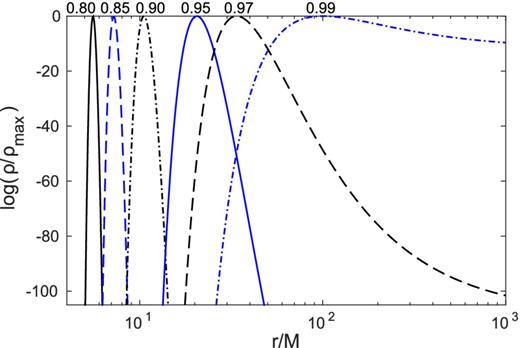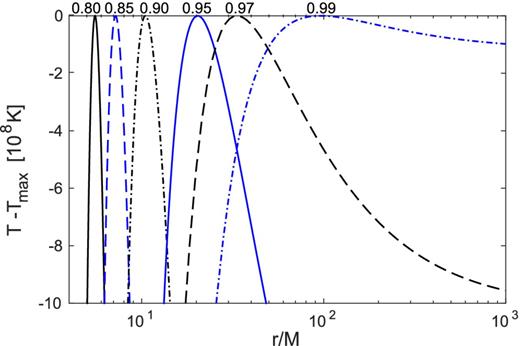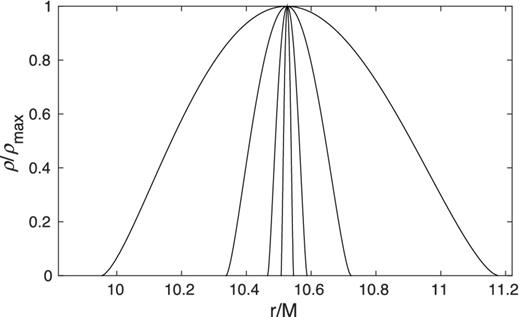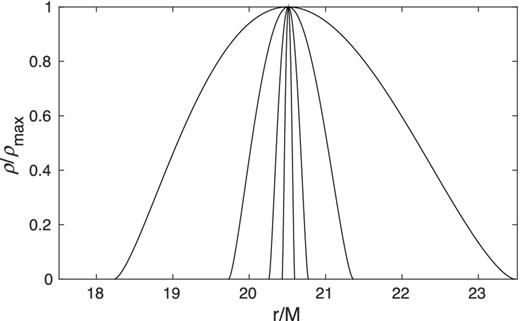-
PDF
- Split View
-
Views
-
Cite
Cite
M. Wielgus, W. Kluźniak, A. Sa̧dowski, R. Narayan, M. Abramowicz, Stable, levitating, optically thin atmospheres of Eddington-luminosity neutron stars, Monthly Notices of the Royal Astronomical Society, Volume 454, Issue 4, 21 December 2015, Pages 3766–3770, https://doi.org/10.1093/mnras/stv2191
Close - Share Icon Share
Abstract
In general relativity, static gaseous atmospheres may be in hydrostatic balance in the absence of a supporting stellar surface, provided that the luminosity is close to the Eddington value. We construct analytic models of optically thin, spherically symmetric shells supported by the radiation pressure of a luminous central body in the Schwarzschild metric. Opacity is assumed to be dominated by Thomson scattering. The inner parts of the atmospheres, where the luminosity locally has supercritical values, are characterized by a density and pressure inversion. The atmospheres are convectively and Rayleigh–Taylor stable, and there is no outflow of gas.
INTRODUCTION
Several systems with super-Eddington luminosity have been reported (e.g. McClintock & Remillard 2006), the ‘LMC transient’ A0535-668 (Bradt & McClintock 1983) being oft discussed. Recently, interest in very luminous neutron stars has been revived with the discovery of a clear example of a neutron star with super-Eddington flux in the guise of the ultraluminous 1.37 s pulsar NuSTAR J095551+6940.8 in the nearby galaxy M82 (Bachetti et al. 2014). It is clear that for some accreting neutron stars, radiation pressure may exceed the pull of gravity close to their surface (at least in a certain solid angle if the radiation is beamed).
In this paper, we report the presence of a new type of atmospheric solutions in general relativity (GR) for neutron stars radiating at nearly Eddington luminosities. These solutions are qualitatively different from the ones obtained in Newtonian physics. In the classical solutions, the atmospheric density increases monotonically as the stellar surface is approached, and this remains true in previously obtained atmospheric solutions in GR (e.g. Paczynski & Anderson 1986), where the atmospheres in question have always been supported at their base by the stellar surface. Here, we report solutions in which the atmosphere has the form of a shell suspended above the stellar surface. The maximum of pressure is attained on a surface enclosing a volume in which the star is contained (together with some space around it), and the atmospheric density and pressure drop precipitously on both sides of that surface, i.e. in the radial direction away from the star (as is usually the case), but also in the radial direction towards the star.
This paper discusses the simplest case of optically thin, spherically symmetric atmospheres in the Schwarzschild metric, which admit of analytic solutions. Optically thick atmospheres require numerical treatment of radiative transfer, and these will be reported elsewhere (Wielgus et al., in preparation).
BALANCE BETWEEN GRAVITY AND RADIATION PRESSURE
ISOTHERMAL ATMOSPHERE
Although we have assumed Thomson scattering, this is not strictly necessary. In fact, all the above considerations in Section 3, as well as equation (4), remain valid if we replace the Thomson value, σT, of the photon electron scattering cross-section by a more general cross-section σ(T), e.g. the Klein–Nishina formula, provided that we make the substitution λ → λ1 = λa1, with a1 = σ(T)/σT.
We stress once again that unlike the decaying atmosphere of the Newtonian limit in equation (13), the GR solution in equations (10)–(12) is not monotonically decreasing with radius everywhere, but instead is monotonically increasing for r < RECS up to the maximum on the ECS, and is only monotonically decreasing for r > RECS, as illustrated in Fig. 1.

Density profiles for the isothermal solutions with T = 107 K. Each curve corresponds to a different value of the luminosity parameter: λ = 0.8, 0.85, 0.9, 0.95, 0.97, 0.99 from left- to right-hand (as labelled at the maxima).
POLYTROPIC ATMOSPHERE

Temperature profiles for the polytropic solutions. Each curve corresponds to a different value of the luminosity parameter: λ = 0.8, 0.85, 0.9, 0.95, 0.97, 0.99 from left- to right-hand. Note that the temperature difference on the y-axis is in units of 108 K.

Density profiles of polytropic Thomson-scattering atmospheres for λ = 0.9. For a luminosity this large, the atmosphere is well separated from the neutron star surface (at R*/M ≈ 5). Temperatures from outside in (more extended atmospheres to less extended atmospheres) are Tmax = 5 × 107 K, 5 × 106 K, 5 × 105 K, 5 × 104 K, respectively, with μ = 1/2 and Γ = 5/3 in all cases. The density maxima are at RECS = 10.5 GM/c2.

Same as Fig. 3, but for λ = 0.95. The density maxima are at RECS = 20.5 GM/c2.
DISCUSSION
We have shown that luminous compact stars (e.g. neutron stars) in Einstein's GR may have atmospheres which are detached from the surface. This may have applications to astrophysical phenomena of those compact objects in which the luminosity is close to its Eddington value, either on a quasi-permanent basis or in a transient state. The former case includes highly luminous neutron stars accreting matter from low-mass stellar companions, such as the Z-sources (which include the brightest X-ray source in the sky, Sco X-1). One would expect quasi-spherical coronae in such sources to be described by our solutions with implications for the hard X-ray spectra in these sources, and possibly also for their quasi-periodic modulations. The latter include X-ray bursts, some of which exhibit the phenomenon of radius expansion (e.g. Strohmayer & Bildsten 2006). However, here we have only considered optically thin atmospheric shells, whereas the atmospheres of X-ray bursters are optically thick. For this reason, we are postponing a detailed discussion of bursters to another paper, where optically thick solutions will be reported (Wielgus et al., in preparation).
The atmospheres presented here can be thought of as an (extreme) example of density and pressure inversion. Atmospheric density inversion owing to variations of opacity has been discussed previously in various contexts. In stellar structure theory discussion of density inversion goes back to Chandrasekhar (1936), see also Sen (1941). In contemporary papers, such layers are often invoked in the context of wind loss2 and stellar pulsations (e.g. Townsend & MacDonald 2006).
The possibility of gas pressure inversion was pointed out by Erika Böhm-Vitense, and explained as a result of a change of sign in the effective gravitational acceleration, geff, with geff being the difference between the true acceleration of gravity and the acceleration owing to radiative forces, which are proportional to the product of opacity and the radiative flux (Böhm-Vitense 1958). This is indeed the cause of the pressure inversion in the atmospheres presented in our paper. However, there are several important differences between the results obtained previously and those reported in this work.
First, the inversion layers familiar from stellar structure theory are caused by variations of opacity, while our results are of a different origin – the (Thomson) opacity in our solutions is uniform, and the density (and pressure) inversion arises solely owing to effects of GR. More generally, its presence is related to purely geometrical effects that allow the radiative flux to have a different functional dependence on the distance from the source than the acceleration of gravity.
Secondly, we are presenting optically thin atmospheres, whereas the stellar discussion occurred for optical depths greater than unity.
Thirdly, in the optically thick case considered by Joss, Salpeter & Ostriker (1973) density inversion occurs in regions where the luminosity is near-Eddington (although still subcritical), the pressure is dominated by radiation, and the temperature gradient is superadiabatic. While the atmospheres discussed in our paper do require near-Eddington luminosities, none of the other conditions is met. Density inversion occurs only in the region of supercritical luminosity, the radiation pressure is zero, as the radiation freely streams through the optically thin gas, and the temperature gradient is subadiabatic for the isothermal atmosphere, of course, as well as for polytropic atmospheres with Γ < 5/3. Gas-pressure inversion occurs at supercritical luminosities. The region of pressure inversion coincides with that of density inversion in the optically thin atmospheres presented here.
Fourthly, Joss et al. (1973), in their discussion of optically thick inversion layers in hydrostatic equilibrium, referring to the work of Lucy & Solomon (1970) observe that their own ‘results do not alter the well-known conclusion that mass-outflow from the surface must result if |$L>L^{\rm s}_{\rm crit}$|, where L and |$L^{\rm s}_{\rm crit}$| are the photospheric values’ of luminosity and its critical value. We note that our atmospheric solutions do ‘alter the well-known conclusion’, as the levitating atmospheric shell is in hydrostatic equilibrium even though L > LEdd in (a part of) the optically thin shell, i.e. the luminosity is supercritical above the photosphere of the underlying luminous star. This is possible because Lucy & Solomon (1970) used Newtonian gravity while our solutions are valid in GR.
We conclude with a brief discussion of stability. The atmospheres presented in this paper are convectively stable, as shown by the appropriate Schwarzschild criterion, in the isothermal case and for polytropes with Γ < 5/3. This result can be intuitively understood by realizing that by the law of Archimedes a hot parcel of gas is initially accelerated in the direction opposite to the gradient of pressure, hence the pressure-inversion layer is as stable as the layer of radially decreasing pressure. A polytropic atmosphere with Γ = 5/3 is marginally stable to convection. The atmospheres are also Rayleigh–Taylor stable as the denser layers are always ‘below’ (in the sense of the direction of effective gravity) the less-dense layers. Investigation of the normal modes of the atmospheres will be presented elsewhere. Here, we only note that (as shown by Abarca & Kluźniak 2015) the radiation drag efficiently damps oscillatory motion in a class of fundamental modes, just as it does the radial and azimuthal motion of test particles (Stahl et al. 2012).
It is a pleasure to thank Lars Bildsten for a discussion on density inversion. We thank the anonymous referee for the very helpful comments. This research was supported in part by the Polish NCN grant UMO-2013/08/A/ST9/00795.
The optically thick case will be treated in a separate paper (Wielgus et al., in preparation).
In LBV and hypergiant stars ‘the most striking propert[y] is the strong density inversion in the outer layers, where a thin gaseous layer floats upon a radiatively supported zone. This is due to the peak in the opacity which forces supra-Eddington luminosities in some layers.’ (Chiosi 1998)
REFERENCES



